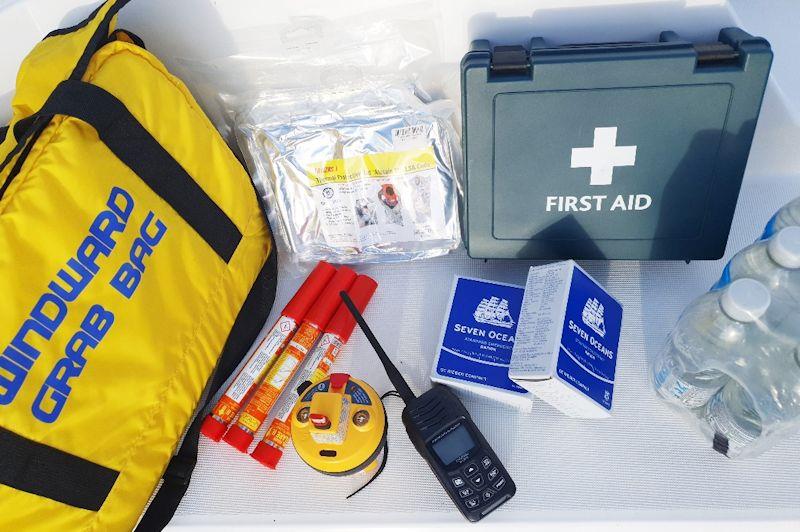
What should I have in my grab bag? A boat safety essential
by Calanach Finlayson 21 Aug 2022 18:00 BST

What should I have in my grab bag? © Andersen Winches
A grab bag is an essential piece of safety equipment for bluewater cruising and offshore racing alike. In the event of an abandon ship, the grab bag may be the only item you have time to take with you before climbing into the liferaft, so should contain all essential items for your survival.
While some racing rules stipulate the contents of a grab bag, there is no such definitive checklist for cruisers. Here we list some of the essentials and other items you might want to include.
The Liferaft
Some liferafts contain basic survival items such as food and water, depending on the specification. Be sure to know exactly what is in yours. Check the information from the manufacturer or look at the certificate from the last inspection. The grab bag should contain additional kit which is not part of the liferaft pack. If in doubt, take what you need in the grab bag anyway!
A basic ISO 9650 with <24hr pack as a minimum should contain the following:
- 1x buoyant knife
- 1x bailer
- 2x sponges
- 2x paddles
- 1x whistle
- 1x torch
- 1x heliograph (signal mirror)
- 6x anti sea sickness pills (per person)
- 1x seasickness bag (per person)
- 3x red handheld flares
- 2x parachute rocket flares
- 1x repair kit
- 1x bellows
- 1x throwing line (30m)
- 1x drogue Source: RYA Sea Survival Handbook
The Grab Bag
The bag itself should be strong & durable, brightly coloured to aid visibility, have a strap or handle so it's easy to grab and be large enough to carry all the survival items. The contents won't necessarily float so ideally you want a grab bag with inherent buoyancy. You may choose to pack some of the contents in smaller dry bags, especially the first aid kit.
There are many dedicated grab bags available in various styles and sizes. The amount of stuff you need to carry will of course depend on the number of crew and length of the voyage you are planning, so choose a grab bag that best suits your needs.
Drinking water
You may have emergency drinking water elsewhere onboard but as one of the most basic survival items, it's important to carry some in the grab bag as well. Dedicated plastic pouches are available for easy stowage or take standard 500ml bottles. In addition, you might consider a portable desalination device. Think about how far from potential rescue you are likely to be and work out how much water you need to survive.
Locator Beacon
The grab bag is a great place to keep your boat's EPIRB (emergency position-indicating radio beacon). Alternatively, take a smaller PLB in the grab bag. This should be in addition to the PLB or = AIS MOB device in your lifejacket.
Flares
Many boats will have a separate flare storage container also in a readily available location. But it's worth sticking at least 3 hand flares in the grab bag
Thermal Protective Aid
Take a couple of TPAs. They are lightweight, compact and might just make the difference in dealing with hypothermia.
First Aid Kit
A proper fist aid kit is a must. Do some research into the necessary contents and don't forget to include sunscreen!
Emergency Rations
For emergency food you are looking for something with a high calorific value that is non-perishable, non-thirst provoking and compact. Specially produced ration packs are a great option but otherwise look for tinned food. Make sure to take enough for each person and that it doesn't need to be cooked.
Handheld VHF
Store your handheld VHF in the grab bag together with some spare batteries. This could allow you to communicate with passing ships or receive instructions from a search and rescue (SAR) team. Click here to see our full range of VHF radios
Additional Items
In addition to the above essentials, here are some further suggestions for items to include in your grab bag:
- Satellite phone plus spare batteries
- Handheld GPS (check if your sat phone has this built in)
- Passports, keys and ships papers
- Sunglasses
- Lip balm
- Toilet paper
- Multitool
- Fishing gear
- Bin bags
- A good book for whiling away the hours on a desert island?
Summary
You might find yourself being forced to evacuate or abandon ship for any number of reasons, not just as a result of bad weather.
If you are going on a longer passage it is always worth preparing a grab bag in addition to your liferaft. Ensure you are familiar with the survival equipment in your liferaft and build up your grab bag with additional items accordingly. Plan your own survival equipment carefully to suit the number of people on board and the nature of your voyage. Sail safe!
If you would like to speak to us about how we can help fill your grab bag, contact us at or to check out our full range of safety equipment, including grab bags, lifejackets and other safety essentials, click the link below:
